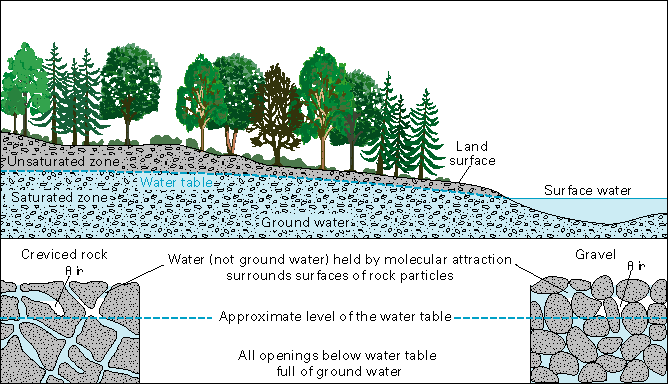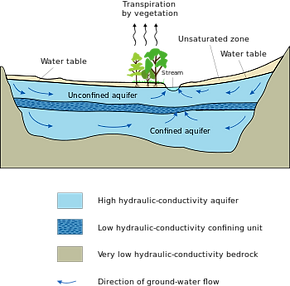ENGINEERING WATER DISTRIBUTION
Water Supply, Treatment and Circulation
Aquifers
An aquifer is an underground layer of water-bearing permeable rock or unconsolidated material (gravel, sand or silt); which ground water can be extracted from using a water well. The diagram to the right shows typical flow directions in a simple aquifer system. It shows two aquifers with one aquitard (a confining layer) between them, surrounded by the bedrock aquiclude, which is in contact with a gaining stream. The water table and unsaturated zone are also seen. An aquitard is a zone within the earth that restricts the flow of groundwater from one aquifer to another. An aquitard can also be called an aquiclude or aquifuge if it is completely impermeable. Aquitards are composed of layers of either clay or non-porous rock with low hydraulic conductivity.
Aquifer wells have been one of the most common methods of obtaining clean, drinking water since the early neolithic era, with examples being found in Central Europe as far back as 5020 BCE. They rely on the natural purity of the groundwater stored in aquifers due to the natural filtering that occurs from the gravel sand and silt that makes up the aquifer.

Above: An example of an aquifer system in the lower Portneuf River valley.
Several different aquifers occur in this valley. In the northern valley, multiple confined aquifers are stacked on top of one another and separated by aquitards made of clay
The aquifers tapped by Chubbuck's municipal wells are in the fractured basalts of the eastern Snake River Plain.
In the southern valley the upper surface of the unconfined aquifer is the water table.

HOW DOES AN AQUIFER BECOME CONTAMINATED?
The above image, sourced from http://imnh.isu.edu/digitalatlas/hydr/concepts/gwater/aquifer.htm [19/12/14] shows how aquifers can become contaminated due to human activities at and near to the surface of the earth. Disposal of wastewater at point sources such as landfills, septic tanks, injection wells and storm drain wells can have an impact on the quality of ground water in an aquifer.
Waste water leaking down the casing of a poorly constructed well bypasses the antural purification done by the soil. HIgh usage of fertilizer, agrichemicals and road de-icing chemicals as well as recharge from crops and other irrigations lands are common reasons for contamination from non point sources.
WATER CYCLE IN AN AQUIFER
Water will discharge from the aquifer and must be replaced by new water, or the water table will fall low and the aquifer will dry up. Every aquifer has a recharge zone and a discharge zone.
Discharge zones can be in springs near the stream, in wetlands at low altitude and also from wells and high-altitude springs.
If the elevation of the water table is high, there will be lots of water in storage. However, if the rate of recharge is less than well production, the water table will decline and therefore the aquifer will hold less water.
*A perched aquifer's water table is sensitive to changes in levels of seasonal recharge, so perched aquifers often go dry during drought years.*
TYPES OF AQUIFER:
PERCHED AQUIFER
UNCONFINED AQUIFER
CONFINED AQUIFER
-
A perched aquifer) is an aquifer that occurs above the regional water table, (in the vadose zone.) This happens when there is an impermeable layer of rock above the main aquifer but below the surface of the land.
-
Unconfined aquifers, also called phreatic aquifers, have their upper boundary at the water table or phreatic surface.
-
Confined aquifers happen where an impermeable rock layer exists that stops water from seeping into the aquifer from the ground surface above. Instead, water seeps into confined aquifers from farther away where the impermeable layer doesn't exist.
Why is Groundwater So Clean?
Aquifers act as natural filters; traping sediment and other particles and providing natural purification of the ground water.The pores in an aquifer's rock purify ground water of particulates but not of dissolved substances or chemcials.
Clay particles and other mineral surfaces in an aquifer also can trap dissolved substances or slow them down so they don't move as fast as water percolating through the aquifer.
Despite natural purification, concentrations of some elements in ground water can be high in instances where the rocks and minerals of an aquifer contribute high concentrations of certain elements.
Iron staining ruins the aesthetic of the drinking water, while elements such as fluoride, uranium, or arsenic occuring can badly damage human health
Below Left: The ground below the water table is saturated with water. The unsaturated zone above the water table still contains water, but is not totally saturated. You can see this in the two drawings at the bottom of the diagram, which show how water is stored in between underground rock particles.
Below Right: Three different types of aquifers are shown: confined, unconfined, and perched.
Recharge zones are typically at higher altitudes but can occur wherever water enters an aquifer, such as from rain, snowmelt, river and reservoir leakage, or from irrigation.
Discharge zone: where water moves downwards from surface water to ground water


Constructing Aquifers: Should we or shouldn't we?
Advantages:
-
Price- due to the simplicity of the pump required and the lack of chemicals required to purify water from other sources, aquifer wells have been used extensively around the world and are still the main source of drinking water in much of Africa.
-
Simplicity- due to the natural purity of aquifer water no filtration is required and therefore the pumping mechanism can be very simple and cheap, for this reason many charities such as WaterAid use these aquifer fed pumps to supply water to remote settlements.
-
Reliability- due to the nature of groundwater, even in very low precipitation environments such as Sub-Saharan Africa, water is almost always available from aquifers
Disadvantages:
-
Purity- although purity is usually satisfactory, especially in LEDCs such as in Sub-Saharan Africa contamination can come into effect between the source and the user, for example fecal matter from grazing animals who congregate around the water source can contaminate the water for other users. The risk of this can be greatly reduced through education as well as constructing infrastructure around the pump such as a pump house in order to reduce the risk of contamination.
-
Salination- if aquifer pumps are used to aggressively then the water table can drop significantly leading to salinisation of the soil as any sodium (I don’t do chemistry) remains in the soil while the water has been removed, this leads to agricultural problems in the area, specifically in Sub-Saharan Africa where subsistence farming is common, this can be catastrophic for a community.
